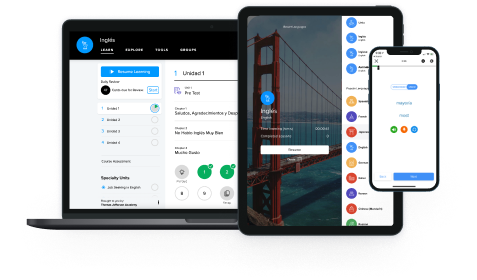The classic use of the dative in German is to mark the indirect object of a sentence, which is the noun that receives something or benefits from an action.
dative (indirect object)
Ich schreibe meiner Großmutter einen Brief.
I’m writing my grandmother a letter.
However, the dative case has several other uses in German as well.
It can mark the object of a dative , like mit(with):
dative prepositiondative
Mit dem Brief möchte ich meine Großmutter überraschen.
With the letter, I want to surprise my grandmother.
It marks the object of a two-case preposition, when that object is a static location:
two-case prepositiondative (location)
Ich bin heute mitten auf dem Pausenhof ausgerutscht.
I slipped in the middle of the playground today.
It is used alongside certain adjectives:
dativeadjective
Mann, war mir das peinlich!
In this article, we’ll describe how to form the dative case, discuss its major uses, and point you towards further resources where you can learn more. Let’s dive in!
How to form the dative case in German?
Like other cases in German, the dative case is primarily marked by adding endings to or to the , , and other that precede a . The noun itself only takes a dative ending in the .
Do you remember the case ending mnemonic we introduced in our post on German definite articles?
You say: “Ree-see, nee-see, merman, sir sir!”
In this mnemonic, the MRMN section represents the dative endings. Can you see all of the dative endings in the chart below? Works like a charm!
Here are some tips to remember:
As a rule of thumb: If you see an article ending in -m, you got yourself a dative!
Be a little careful with feminine nouns, since the dative and the genitive case take the same -r ending. (The definite article der is also used for the nominative masculine too!)
Note that the noun itself does not take an ending, unless it’s in the plural (or if the noun is a strong noun).
If you want to learn more about the different forms of any of the word types above, follow the links in the table!
When to use the dative case in German?
In German, the dative case is used for indirect objects, for the objects of certain prepositions, and to represent individuals that experience certain states represented by adjectives. Let’s have a look at each of these uses one-by-one.
The indirect object: Which German verbs take the dative case?
In German, the dative case is used to mark the indirect object of a verb. So if a verb takes an indirect object, that noun will be in the dative case.
The indirect object of a sentence is the noun that receives something or otherwise benefits from an action, but is not directly affected by the action of a verb. The indirect object is usually the noun “to which” something is transferred or “for whom” it was done.
Many verbs that take an indirect object will also take a direct object (which does directly undergo the action of the verb).
verbindirect objectdirect object
Ich schreibe meiner Großmutter einen Brief.
I’m writing my grandmother a letter.
→ The grandmother is the person “to whom” I am writing, so that is the indirect object.
Der Verkäufer gibt dem Kunden das Wechselgeld.
The seller gives the change to the customer.
→ The customer is the person “to whom” the change is being given.
Schickst du mir nach der Sitzung bitte die Unterlagen?
Will you please send me the papers after the meeting?
→ I am the person “to whom” the papers are given.
However, in German, some verbs take only an indirect object in the dative case. With these verbs, the indirect object is still generally receiving something or benefitting from the action, though here it can be a bit more abstract.
verbindirect object
Entschuldigen Sie bitte, können Sie mir bitte helfen?
Excuse me, can you help me please?
→ Help is being given to me.
Ich stimme dir voll und ganz zu.
I agree with you wholeheartedly.
→ Agreement is being given to me.
Die Quelle ist vertrauenswürdig. Du kannst ihr glauben.
The source is trustworthy. You can believe it.
→ Trust is being given to me.
Check out this list of common verbs that take the dative case to get a better idea of the sorts of actions that take indirect objects in German!
What are dative prepositions in German?
In German, dative are prepositions that are used to introduce a noun in the dative case. Some of the most common ones are: aus(out of), von(from), mit(with), bei(at), and seit(since).
prepositiondative
Rauch kommt aus dem Schornstein.
Smoke is coming out of the chimney.
Ich gehe mit Freunden ins Restaurant.
I am going to the restaurant with friends.
Dieses Andenken ist vom Berliner Zoo.
This souvenir is from the Berlin zoo.
→ vom = von(from) + dem(the, dat.)
Check out our post on German dative prepositions for a much longer list and more examples!
When to use the dative with two-case prepositions in German?
The dative case is used after a two-case preposition when the noun represents the location of the action rather than a goal towards which the action is moving.
Two-case prepositions in German are words like in(in, into) or unter(under) that can either be used to describe the location of some action or the direction in which some movement is heading. We use the dative only when such prepositions are used to describe a location. If they describe the direction of movement we use the accusative instead.
| two-case prepositiondative Die Milch ist im Kühlschrank. The milk is in the fridge. → im = in(in) + dem(the, dat.) |
| two-case prepositionaccusative Bitte stelle die Milch in den Kühlschrank. Please put the milk into the fridge. |
Some prepositions, like in(in), vor(before, in front) and über(over, all along) are used both as prepositions of location and time. While these function as two-way prepositions when referring to location, their case is fixed when referring to time! For example, vor(before) is always dative when used to describe something that happened “before some moment.”
two-case prepositiondativeaccusative
Wir warten vor der Schule.
We are waiting in front of the school.
Bitte fahren Sie Ihre Kinder nicht direkt vor die Schule.
Please do not drive your children directly in front of the school.
→ a direction
preposition of timedative
Vor dem Mittagessen waschen wir uns die Hände.
Before lunch, we wash our hands.
→ a time description: ALWAYS dative
Which German adjectives take the dative case?
In German, adjectives that are used with the dative case usually have to do with emotions or physical sensations that can be experienced. The experiencer is given in the dative case. Such adjectives are often introduced by sein(to be) or werden(become).
experiencer (dative)adjective
Diese Frage ist mir unangenehm.
This question is uncomfortable for me.
Der Klasse war von Anfang an klar, dass die Prüfung nicht ganz einfach sein wird.
It was clear to the class from the beginning that the test would not be easy.
Bist du der Herausforderung gewachsen?
Are you up to the challenge?
lit. Are you grown to the challenge?
Bei diesem Anblick wird einem warm ums Herzen.
This sight warms the heart.
lit. At this sight, it gets warm around the heart for me.
Often these adjectives can be used with the nominative case as well, but there is a distinction in meaning. The nominative is used for an adjective describing a fixed property, whereas the dative is used to express a passing state:
nominativeadjective
→ I am inherently boring.
dativeadjective
I am bored.
lit. To me (it) is boring.
→ I am experiencing a boring sensation.
This distinction is made in adjectives expressing emotions, feelings or physical sensations: heiss(feel hot), kalt(feel cold), übel(feel sick), schlecht(feel sick), schwindlig(feel dizzy) etc.
Check out this list of adjectives that commonly trigger the dative to see more examples!
Summary
With the dative in your German backpack, you’re well equipped to juggle verbs and their objects like a linguistic circus artist! To recap, in this article, we have learned the following points about the dative:
Use the endings MRMN to mark a word in the dative case.
Here are the major uses of this case:
to mark an indirect object
after dative prepositions
after two-case prepositions, if you’re describing a location
alongside certain adjectives that describe experiences or emotions
It is important to practice using the dative case in context and to become familiar with the various verbs, prepositions, and pronouns that require it. Why not go for it right away with German dative case exercises? Happy learning!

